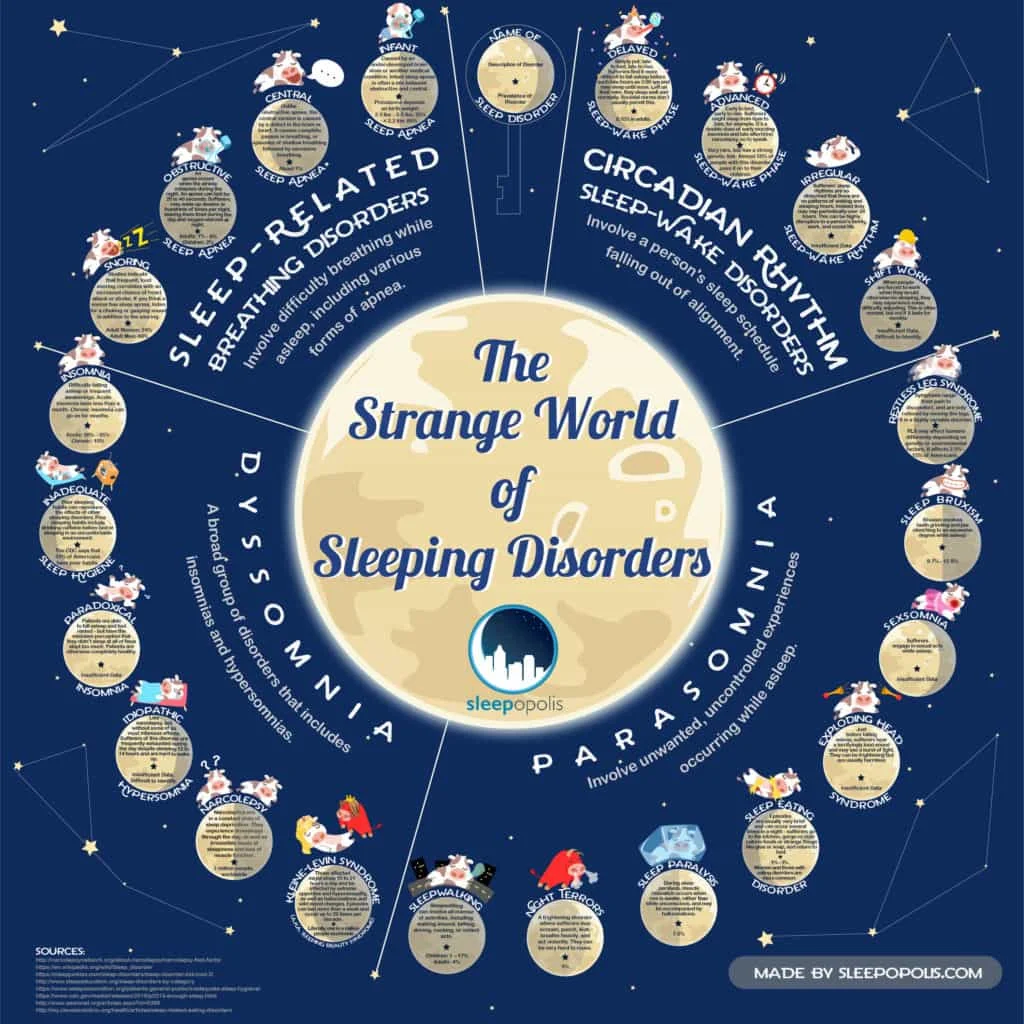According to the National Sleep Foundation and the National Commission of Sleep Disorders Research, about 40 million American suffer from some form of sleeping disorder. Many of them are undiagnosed. That’s almost 1 in 8 people – so among your extended family, the chances are high that one of your relatives suffers from a sleep disorder.
Note: The content on Sleepopolis is meant to be fun and informative, but it shouldn’t be taken as medical advice. Further, it should never supplant advice or recommendations given by trained professionals. If you feel you may be suffering from a sleep disorder, please contact your healthcare provider immediately.
Click here or on image to enlarge the infographic
Like this infographic? Consider sharing it with this link or embed on your own site with the embed code below!
What do you imagine when you hear the term “sleep disorder?” Maybe insomnia or sleep apnea, which are two of the most common disorders. Or maybe you imagine something more exotic like sleep walking or sleep eating. But what about exploding head syndrome, sexsomnia, or night terrors? Let’s review some of the sleep disorders that Americans suffer from.
FAQ: What’s the Best Mattress for Back Pain?
Parasomnias
A fascinating set of sleep disorders that involve unwanted, uncontrolled experiences occurring while asleep.
Sleepwalking
- Sleepwalking can involve all manner of activities, including: walking around, talking, driving, cooking, or violent acts. You can wake a sleepwalker, but should do so gently and cautiously.
- Affects 1% – 17% of children and 4% of adults.
Night Terrors
- A frightening disorder where sufferers may scream, punch, kick, breathe heavily, and act violently. They can be very hard to rouse.
- Affects 3% of the general population.
Sleep Eating Disorder
- Sleep eating episodes may occur once in a night or several times. They are usually very quick – sufferers go to the kitchen, gorge on high calorie food, and return to bed. They might eat some very strange things too, such as glue or soap, and may start fires trying to cook.
- Affects 1% – 3% of the general population. Women and those with eating disorders are the most commonly affected.
Sleep Paralysis
- During sleep paralysis, muscle relaxation occurs when one is awake, rather than while unconscious, and may be accompanied by hallucinations.
- Affects 7.6% of the general population.
Exploding Head Syndrome
- Not what it sounds like, but still terrifying to those affected. Just before falling asleep, sufferers hear a terrifyingly loud sound and may see a burst of light. They can be frightening but are usually harmless.
- Although recognized as a disorder, there is insufficient data available to conclude how many people are affected by exploding head syndrome.
Sexsomnia
- Sufferers engage in sexual acts while asleep.
- Despite being such a shocking phenomenon, sexsomnia is not well understood and there is insufficient data available to conclude how widespread it is.
Sleep Bruxism
- Bruxism involves teeth grinding and jaw clenching to an excessive degree while asleep.
- Affects 9.7% – 15.9% of the general population.
Restless Leg Syndrome
- Symptoms range from pain to discomfort, and are only relieved by moving the legs. It is a highly variable disorder.
- RLS may affect humans differently depending on genetic or environmental factors. It affects 2.5% – 15% of Americans.
Dyssomnias
This broad group of sleeping disorders includes insomnias, where people don’t get enough sleep or are unable to remain asleep, and hypersomnias, where people get too much sleep.
Insomnia
- Difficulty falling asleep or frequent awakenings. Acute insomnia lasts less than a month. Chronic insomnia can go on for months. Oddly, a U.S. study found that mild to moderate insomnia is associated with an increase in life span.
- Acute Insomnia affects 30% – 35% of the general population. Chronic Insomnia affects a smaller 10% of the population.
Narcolepsy
- Narcoleptics are in a constant state of sleep deprivation. They experience drowsiness through the day, as well as irresistible bouts of sleepiness and loss of muscle function.
- 3 million people worldwide are affected by narcolepsy.
Kleine-Levin Syndrome
- Also known as Sleeping Beauty syndrome. Those affected might sleep 15 to 21 hours a day and be affected by extreme appetites and hypersexuality, as well as hallucinations and wild mood changes. Episodes can last more than a week and occur up to 20 times per decade.
- Kleine-Levin Syndrome is literally a one-in-a-million disorder worldwide.
Paradoxical Insomnia
- Patients are able to fall asleep and feel rested – but have the mistaken perception that they didn’t sleep at all or have slept too much. Patients are otherwise completely healthy, even if they say that they haven’t slept properly in years.
- As you can imagine, this disorder is very difficult to study and identify. As such, there is insufficient data to conclude how many people are affected by it.
Inadequate Sleep Hygiene
- Poor sleeping habits can reproduce the effects of other sleeping disorders. Poor sleeping habits include drinking caffeine before bed or dozing on an uncomfortable mattress.
- The CDC says that 33% of Americans have poor sleep habits.
Idiopathic Hypersomnia
- Like narcolepsy, but without some of its most infamous effects. Sufferers of this disorder are frequently exhausted during the day despite sleeping 12 to 14 hours and are hard to wake up.
- Unfortunately, this debilitating disorder is often mistaken for narcolepsy. This makes it difficult to identify and even more difficult to treat.
Sleep-Related Breathing Disorders
As the description implies, this set of sleep disorders involves difficulty breathing while asleep. This includes several variations of sleep apnea.
Obstructive Sleep Apnea
- An apnea occurs when the airway collapses during the night. An apnea can last for 20 to 40 seconds. Suffers may wake up dozens or hundreds of times per night, leaving them tired during the day and oxygen-starved at night. It causes great damage to the heart.
- Affects 1% – 6% of adults and 2% of children.
Snoring
- Studies indicate that frequent, loud snoring correlates with an increased chance of heart attack or stroke. If you think a snorer has sleep apnea, listen for a choking or gasping sound in addition to the snoring.
- Argue with your spouse all you like, but here are the scientific facts: 40% of men and 24% of women snore.
Central Sleep Apnea
- Unlike obstructive apnea, the central version is caused by a defect in the brain or heart. It causes complete pauses in breathing, or episodes of shallow breathing followed by excessive breathing.
- Affects about 1% of the general population.
Infant Sleep Apnea
- Caused by an under-developed brain stem or another medical condition. Infant sleep apnea is often a mix between obstructive and central.
- The prevalence of infant sleep apnea depends on the birth weight of the newborn. Babies born weighing less than 2.2 pounds experience it at rates of 85%. Babies born weighing between 2.3 and 5.5 pounds experience it at rates of 25%.
Circadian Rhythm Sleep-Wake Disorders
These sleep disorders involve a person’s sleep schedule falling out of alignment.
Delayed Sleep-Wake Phase
- Simply put: late to bed, late to rise. Sufferers find it more difficult to fall asleep before such late hours as 3:00 am and may sleep until noon. Left on their own, they sleep well and normally. Societal norms don’t usually permit this.
- An uncommon disorder that affects 0.15% of adults.
Advanced Sleep-Wake Phase
- Early to bed, early to rise. Sufferers might sleep from 6pm to 3am, for example. It’s a double dose of early morning insomnia and late afternoon narcolepsy, so to speak.
- Even more uncommon than its cousin, delayed sleep-wake phase. However, advanced sleep-wake phase does appear to have a strong genetic link. Almost 50% of people with this disorder pass it on to their children.
Shift Work
- When people are forced to work when they would otherwise be sleeping, they may experience some difficulty adjusting. This is often normal, but not if it lasts for months.
- Overlap with insomnia and other disorders makes shift work difficult to identify and treat.
Irregular Sleep-Wake Rhythm
- Sufferers’ sleep rhythms are so disturbed that there are no patterns of waking and sleeping hours. Instead they may nap periodically over 24 hours. This can be highly disruptive to a person’s family, work, and social life.
- There is unfortunately insufficient data available to determine how many people are affected by irregular sleep-wake rhythm.
These disorders sound inconvenient and some of them are life-threatening. However, there are two diseases (not disorders) related to sleep that are truly terrifying – Fatal Familial Insomnia (FFI) and Sleeping Sickness (African trypanosomiasis).
FFI works, at first, like regular insomnia. But over time, sufferers find themselves able to sleep less and less until they enter a waking coma and die. Sleeping Sickness is difficult to detect, since it the onset of its symptoms resemble a common cold or flu virus. However, over time, Sleeping Sickness passes through the blood-brain barrier and can do permanent brain damage.
They are as fascinating as they are deadly. Let’s take a look at how they work:
Fatal Familial Insomnia (FFI)
- FFI is caused by a mutation in the PRNP gene. Imagine this mutation as a stick of dynamite slowly burning out its fuse.
- Between the ages of 32 and 62, with 51 being the average, that dynamite explodes. Imagine the PRNP gene as a factory – it produces the important prion protein. The dynamite causes this prion protein to come out misshapen.
- Bad prions spread into the thalamus, at the center of the brain, and begin killing neurons. If the PRNP was a factory and the prion protein was food, you can think of the contaminated prions as poison for hungry neurons. It’s a case of the “well” of the brain being poisoned.
- In the first stage, FFI begins with a sudden bout of insomnia. This grows worse over the course of 4 months and is accompanied by dementia, panic attacks, paranoia, and the development of new phobias.
- In the second stage, vivid hallucinations begin to occur due to lack of sleep. Panic attacks become stronger and more frequent over the course of 5 months. Starved for sleep, some patients will enter a stupor between sleep and wakefulness. During this time they may experience ataxia and loss of muscle control. Some patients have been observed acting out elements of their daily lives, living a waking dream.
- In the third stage, sleep becomes impossible for most. Rapid weight loss and loss of muscle control follows over the course of three months.
- In the final stage, complete dementia (effectively insanity caused by a lack of sleep) sets in. The patient becomes unresponsive and mute, but is still awake. This waking coma lasts 6 months and results in death.
- Life expectancy with FFI is 18 months after onset. There is no known cure. Sleeping pills and drugs are known to worsen the progress of the disease.
More Facts About Fatal Familial Insomnia
- The mutation that causes FFI is passed through families for generations – the worst kind of family heirloom. The gene only needs to come from one parent. Every child that a person affected by FFI has will have a 50% chance of sharing their parent’s fate.
- As of 1998, 25 families are known to carry the mutation for FFI. By nationality, they are: Eight German, Five Italian, Four American, Two French, Two Australian, Two British, One Japanese, One Austrian.
- As of 2016, there have been 24 cases of FFI that are more frightening – they weren’t passed down through the family, but were instead completely spontaneous.
Sleeping Sickness (African trypanosomiasis)
- Sleeping Sickness is caused by a parasite known as Trypanosoma brucei. For ease of memory and the sake of this metaphor, we’ll call him “Bruce.”
- Bruce lives in a tsetse fly, but dreams of owning a home in a human body. Sleeping Sickness is spread by the bit of infected tsetse flies. Once Bruce gets into the bloodstream, there are two paths the sleeping sickness can go down. Which path the disease takes will depend on the type of Trypanosoma brucei that the fly is infected with…
- In the more common version, a patient could be infected for months or years without knowing it. Once symptoms begin, the patient is often already in the more dangerous neurological phase of the disease, where damage is permanent. This version comes from Trypanosoma brucei gambiense…but we’ll call him Bruce Gambi.
- The rarer form of the disease causes an acute infection. Symptoms can be seen within weeks or months, and it progresses very quickly to the dangerous neurological stage and death. This version comes from Trypanosoma brucei rhodesiense…we’ll call him Bruce Rhodes.
- The symptoms of Sleeping Sickness can be difficult to detect before it’s too late. The WHO emphasizes that regular screening is necessary to pick up the disease in its early and easily treatable stages.
- In the first stage, Bruce gets to work spreading throughout human tissues, blood, and lymph nodes. Patients experience fever, headaches, joint pains, and itching. The fever comes and goes in day to week bursts, with week to month breaks in between, making it difficult to tell what the cause is.
- In the second and final stage, Bruce gets greedy. Once Bruce passes the blood-brain barrier, the second stage of sleeping sickness begins. Symptoms include changes in behavior, psychotic episodes, extreme apathy, and a disturbance of the patient’s sleep cycle as the brain is attacked.
- Damage done to the brain in the second stage is permanent. Treatment during this stage is also extremely difficult. Most second stage treatments can be lethal in their own right. Those affected by Sleeping Sickness might never know until the second stage is reached and it is too late.
More Facts About Sleeping Sickness
- In 1734, British naval surgeon John Atkins described the sudden onset of the disease: “The Sleepy Distemper…gives no other previous notice than a want of appetite two or three days before…” In its worst stages, Sleeping Sickness leads to coma, organ failure, and eventually death. Atkins also described that those who managed to avoid death were rendered “Ideot,” from the permanent damage to their brain.
- Sleeping Sickness is a threat to over 60 million people living in 36 countries across sub-Saharan Africa. More than 48,000 people across Uganda and western Kenya died of it in 2008. Most cases now come out of the Democratic Republic of the Congo. In 1998, 40,000 cases were reported – but it’s estimated that 300,000 or more went undiagnosed and untreated.
- Contrary to popular belief, Sleeping Sickness does not cause a person to sleep all the time. It does make them more apathetic and upends their sleep cycle. Those affected by Sleeping Sickness might sleep all day and be wide awake at night, or experience sudden bursts of sleep and wakefulness during the day.



























